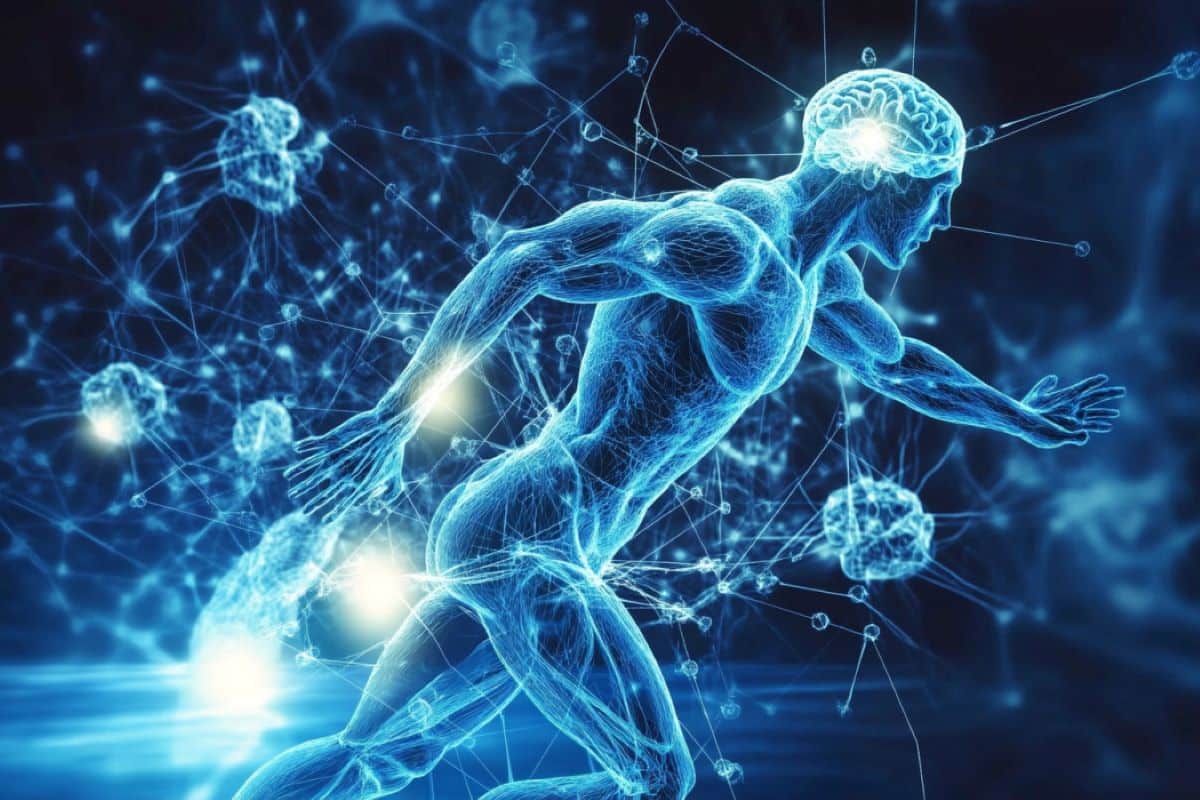Summary: Researchers found that exercise promotes neuron growth through both biochemical signals (myokines) and physical stretching. Muscle cells, when contracted, release myokines that boost neuron growth and maturity. Furthermore, neurons that were “exercised” through mechanical movement grew just as much as those exposed to myokines.
These findings reveal the dual role of exercise in stimulating nerves, offering hope for developing therapies targeting nerve repair and neurodegenerative diseases. This research opens new avenues in treating nerve damage through “exercise as medicine.”
Key Facts:
- Exercise releases muscle-generated signals, promoting neuron growth.
- Mechanical stretching of neurons alone also boosts their growth significantly.
- Both biochemical and physical exercise effects are vital for neuron health.
Source: MIT
There’s no doubt that exercise does a body good. Regular activity not only strengthens muscles but can bolster our bones, blood vessels, and immune system.
Now, MIT engineers have found that exercise can also have benefits at the level of individual neurons. They observed that when muscles contract during exercise, they release a soup of biochemical signals called myokines.

In the presence of these muscle-generated signals, neurons grew four times farther compared to neurons that were not exposed to myokines. These cellular-level experiments suggest that exercise can have a significant biochemical effect on nerve growth.
Surprisingly, the researchers also found that neurons respond not only to the biochemical signals of exercise but also to its physical impacts.
The team observed that when neurons are repeatedly pulled back and forth, similarly to how muscles contract and expand during exercise, the neurons grow just as much as when they are exposed to a muscle’s myokines.
While previous studies have indicated a potential biochemical link between muscle activity and nerve growth, this study is the first to show that physical effects can be just as important, the researchers say.
The results, which will be published in the journal Advanced Healthcare Materials, shed light on the connection between muscles and nerves during exercise, and could inform exercise-related therapies for repairing damaged and deteriorating nerves.
“Now that we know this muscle-nerve crosstalk exists, it can be useful for treating things like nerve injury, where communication between nerve and muscle is cut off,” says Ritu Raman, the Eugene Bell Career Development Assistant Professor of Mechanical Engineering at MIT.
“Maybe if we stimulate the muscle, we could encourage the nerve to heal, and restore mobility to those who have lost it due to traumatic injury or neurodegenerative diseases.”
Raman is the senior author of the new study, which includes Angel Bu, Ferdows Afghah, Nicolas Castro, Maheera Bawa, Sonika Kohli, Karina Shah, and Brandon Rios of MIT’s Department of Mechanical Engineering, and Vincent Butty of MIT’s Koch Institute for Integrative Cancer Research.
Muscle talk
In 2023, Raman and her colleagues reported that they could restore mobility in mice that had experienced a traumatic muscle injury, by first implanting muscle tissue at the site of injury, then exercising the new tissue by stimulating it repeatedly with light.
Over time, they found that the exercised graft helped mice to regain their motor function, reaching activity levels comparable to those of healthy mice.
When the researchers analyzed the graft itself, it appeared that regular exercise stimulated the grafted muscle to produce certain biochemical signals that are known to promote nerve and blood vessel growth.
“That was interesting because we always think that nerves control muscle, but we don’t think of muscles talking back to nerves,” Raman says.
“So, we started to think stimulating muscle was encouraging nerve growth. And people replied that maybe that’s the case, but there’s hundreds of other cell types in an animal, and it’s really hard to prove that the nerve is growing more because of the muscle, rather than the immune system or something else playing a role.”
In their new study, the team set out to determine whether exercising muscles has any direct effect on how nerves grow, by focusing solely on muscle and nerve tissue. The researchers grew mouse muscle cells into long fibers that then fused to form a small sheet of mature muscle tissue about the size of a quarter.
The team genetically modified the muscle to contract in response to light. With this modification, the team could flash a light repeatedly, causing the muscle to squeeze in response, in a way that mimicked the act of exercise.
Raman previously developed a novel gel mat on which to grow and exercise muscle tissue. The gel’s properties are such that it can support muscle tissue and prevent it from peeling away as the researchers stimulated the muscle to exercise.
The team then collected samples of the surrounding solution in which the muscle tissue was exercised, thinking that the solution should hold myokines, including growth factors, RNA, and a mix of other proteins.
“I would think of myokines as a biochemical soup of things that muscles secrete, some of which could be good for nerves and others that might have nothing to do with nerves,” Raman says.
“Muscles are pretty much always secreting myokines, but when you exercise them, they make more.”
“Exercise as medicine”
The team transferred the myokine solution to a separate dish containing motor neurons — nerves found in the spinal cord that control muscles involved in voluntary movement. The researchers grew the neurons from stem cells derived from mice. As with the muscle tissue, the neurons were grown on a similar gel mat.
After the neurons were exposed to the myokine mixture, the team observed that they quickly began to grow, four times faster than neurons that did not receive the biochemical solution.
“They grow much farther and faster, and the effect is pretty immediate,” Raman notes.
For a closer look at how neurons changed in response to the exercise-induced myokines, the team ran a genetic analysis, extracting RNA from the neurons to see whether the myokines induced any change in the expression of certain neuronal genes.
“We saw that many of the genes up-regulated in the exercise-stimulated neurons was not only related to neuron growth, but also neuron maturation, how well they talk to muscles and other nerves, and how mature the axons are,” Raman says.
“Exercise seems to impact not just neuron growth but also how mature and well-functioning they are.”
The results suggest that biochemical effects of exercise can promote neuron growth. Then the group wondered: Could exercise’s purely physical impacts have a similar benefit?
“Neurons are physically attached to muscles, so they are also stretching and moving with the muscle,” Raman says.
“We also wanted to see, even in the absence of biochemical cues from muscle, could we stretch the neurons back and forth, mimicking the mechanical forces (of exercise), and could that have an impact on growth as well?”
To answer this, the researchers grew a different set of motor neurons on a gel mat that they embedded with tiny magnets. They then used an external magnet to jiggle the mat — and the neurons — back and forth. In this way, they “exercised” the neurons, for 30 minutes a day.
To their surprise, they found that this mechanical exercise stimulated the neurons to grow just as much as the myokine-induced neurons, growing significantly farther than neurons that received no form of exercise.
“That’s a good sign because it tells us both biochemical and physical effects of exercise are equally important,” Raman says.
Now that the group has shown that exercising muscle can promote nerve growth at the cellular level, they plan to study how targeted muscle stimulation can be used to grow and heal damaged nerves, and restore mobility for people who are living with a neurodegenerative disease such as ALS.
“This is just our first step toward understanding and controlling exercise as medicine,” Raman says.
About this exercise and neuroscience research news
Author: Abby Abazorius
Source: MIT
Contact: Abby Abazorius – MIT
Image: The image is credited to Neuroscience News
Original Research: Open access.
“Actuating Extracellular Matrices Decouple the Mechanical and Biochemical Effects of Muscle Contraction on Motor Neurons” by Ritu Raman et al. Advanced Healthcare Materials
Abstract
Actuating Extracellular Matrices Decouple the Mechanical and Biochemical Effects of Muscle Contraction on Motor Neurons
Emerging in vivo evidence suggests that repeated muscle contraction, or exercise, impacts peripheral nerves.
However, the difficulty of isolating the muscle-specific impact on motor neurons in vivo, as well as the inability to decouple the biochemical and mechanical impacts of muscle contraction in this setting, motivates investigating this phenomenon in vitro.
This study demonstrates that tuning the mechanical properties of fibrin enables longitudinal culture of highly contractile skeletal muscle monolayers, enabling functional characterization of and long-term secretome harvesting from exercised tissues.
Motor neurons stimulated with exercised muscle-secreted factors significantly upregulate neurite outgrowth and migration, with an effect size dependent on muscle contraction intensity.
Actuating magnetic microparticles embedded within fibrin hydrogels enable dynamically stretching motor neurons and non-invasively mimicking the mechanical effects of muscle contraction.
Interestingly, axonogenesis is similarly upregulated in both mechanically and biochemically stimulated motor neurons, but RNA sequencing reveals different transcriptomic signatures between groups, with biochemical stimulation having a greater impact on cell signaling related to axonogenesis and synapse maturation.
This study leverages actuating extracellular matrices to robustly validate a previously hypothesized role for muscle contraction in regulating motor neuron growth and maturation from the bottom-up through both mechanical and biochemical signaling.







